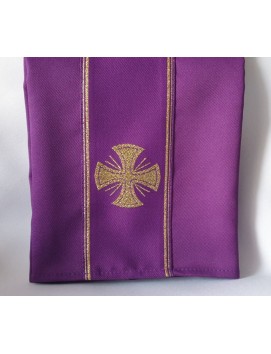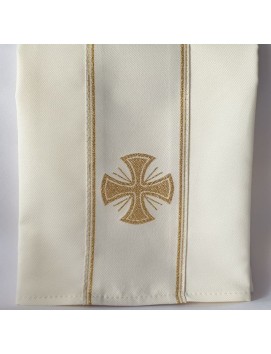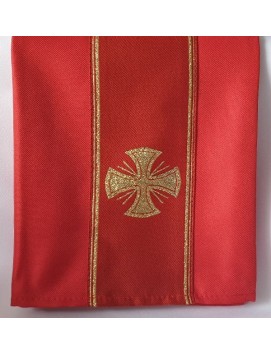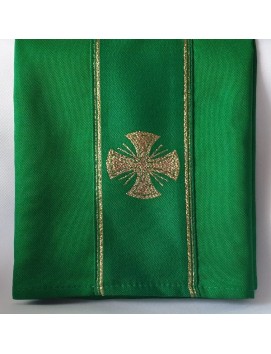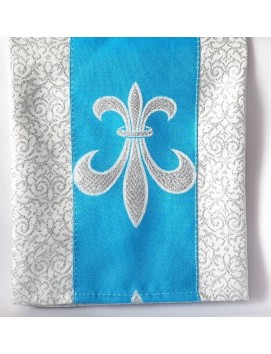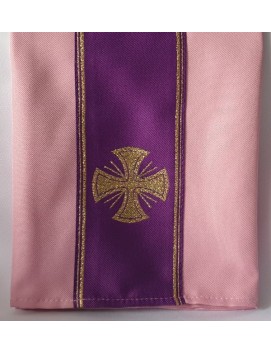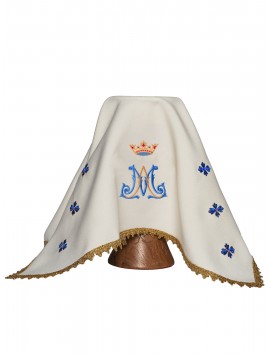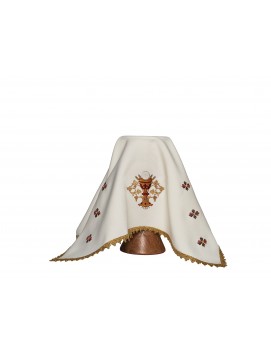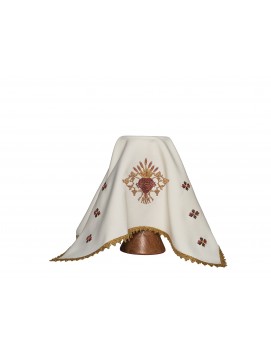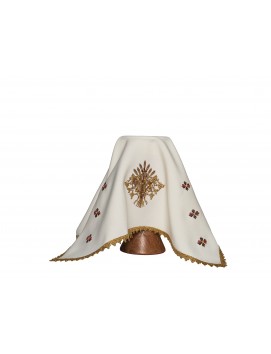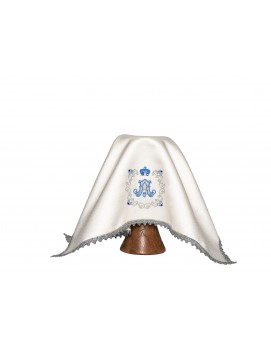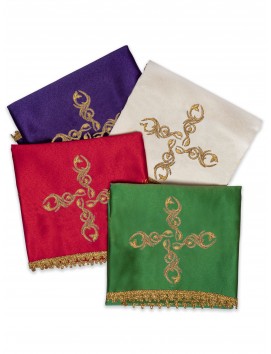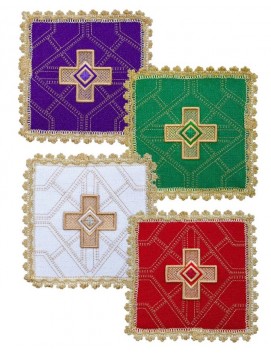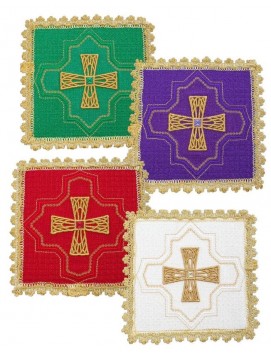No products
Chalice veil
A Chalice Veil is a square of material that covers the chalice and paten until they are needed for preparation of the altar at the Eucharist. It is a liturgical vestment that is usually the same color as the vestments. The chalice veil is placed on top of the pall, which rests on top of the chalice and paten. The veil is used to cover the chalice when it is carried to and from the altar during the celebration of Mass. It is also used to cover the chalice during the Liturgy of the Word, which is the first part of the Mass. The chalice veil is an important part of the Catholic liturgy and is used to adorn and dignify the vessels that will contain the Body and Blood of the Lord. The veil is usually adorned with embroidery depicting the Eucharistic motif using purple threads. The chalice veil is considered a sacred cloth and is treated with great reverence. It is an essential part of the "vested chalice," which refers to the chalice and paten that are completely prepared for the liturgy with chalice veil and burse.
A Chalice Veil is a square of material that covers the chalice and paten until they are needed for preparation of the altar at the Eucharist. It is a liturgical vestment that is usually the same color as the vestments. The chalice veil is placed on top of the pall, which rests on top of the chalice and paten. The veil is used to cover the chalice when it is carried to and from the altar during the celebration of Mass. It is also used to cover the chalice during the Liturgy of the Word, which is the first part of the Mass. The chalice veil is an important part of the Catholic liturgy and is used to adorn and dignify the vessels that will contain the Body and Blood of the Lord. The veil is usually adorned with embroidery depicting the Eucharistic motif using purple threads. The chalice veil is considered a sacred cloth and is treated with great reverence. It is an essential part of the "vested chalice," which refers to the chalice and paten that are completely prepared for the liturgy with chalice veil and burse.
Unveiling the Mystery: The Chalice Veil
The chalice veil, a term that might sound like something straight out of a medieval novel, is actually a deeply significant piece of fabric in the world of liturgical ceremonies. But what exactly is it, and why does it hold such importance in religious services? Let's dive into the fascinating world of the chalice veil, uncovering its history, purpose, and the symbolism that makes it so much more than just a piece of cloth.
What is a Chalice Veil?
The chalice veil is a square piece of cloth that covers the chalice and paten until they are needed for the preparation of the altar during the celebration of the Eucharist. It's not just any cloth, though. This veil is usually made of the same material and color as the priest's vestments, symbolizing unity and reverence in the service.
The Purpose Behind the Veil
You might be wondering, why cover the chalice at all? The chalice veil serves a dual purpose: practical and symbolic. Practically, it protects the sacred vessels from dust and any foreign particles, ensuring that the wine and host remain pure for the Eucharist. Symbolically, it represents the veiling of something sacred, a theme deeply rooted in Christian tradition. Just as the tabernacle and sometimes even the altar are veiled, the chalice veil signifies the sacredness of the vessels it covers.
A Brief History
The use of the chalice veil can be traced back to the early days of Christianity, although its formal introduction into the Roman Rite is relatively recent, around the 16th century. Initially, the chalice and paten were not veiled, but as the liturgy evolved, the veil became an integral part of the Eucharistic celebration, symbolizing the reverence and mystery surrounding the sacrament.
Symbolism and Significance
The chalice veil is rich in symbolism. It reminds us of the veil in the Temple of Jerusalem, which separated the Holy of Holies from the rest of the temple. Similarly, the chalice veil separates the sacred from the mundane, inviting the faithful to reflect on the mystery of the Eucharist. The act of unveiling the chalice during the service symbolizes the revelation of Christ in the Eucharist, echoing the tearing of the Temple veil at the moment of Jesus' death.
FAQs About the Chalice Veil
Why is the chalice veil the same color as the priest's vestments?
The chalice veil is matched with the priest's vestments to symbolize unity and the seamless nature of the liturgical celebration.
Can any cloth be used as a chalice veil?
No, the chalice veil is usually made of fine materials and often decorated to reflect its sacred purpose. It's treated with the same reverence as other liturgical vestments.
Is the chalice veil used in all Christian denominations?
The use of the chalice veil is most common in the Roman Catholic, Anglican, and some Eastern Orthodox traditions. Its use varies among other Christian denominations.
What happens to the chalice veil after the Eucharist?
After the Eucharist, the chalice veil is carefully folded and stored until it is needed again. It is treated with reverence, similar to other sacred objects used in the liturgy.
The Chalice Veil Today
In contemporary liturgical practices, the chalice veil continues to be a symbol of reverence and mystery. While its practical purpose remains, the symbolic act of veiling and unveiling the chalice invites the faithful to ponder the deep mysteries of faith. The chalice veil, therefore, serves as a bridge between the visible and the invisible, the material and the spiritual, guiding the congregation into a deeper understanding of the sacred.
In a world where the sacred often gets lost in the hustle and bustle of daily life, the chalice veil stands as a gentle reminder of the presence of the divine in the midst of the ordinary. It invites us to pause, reflect, and appreciate the profound mysteries that lie at the heart of the Christian faith.


